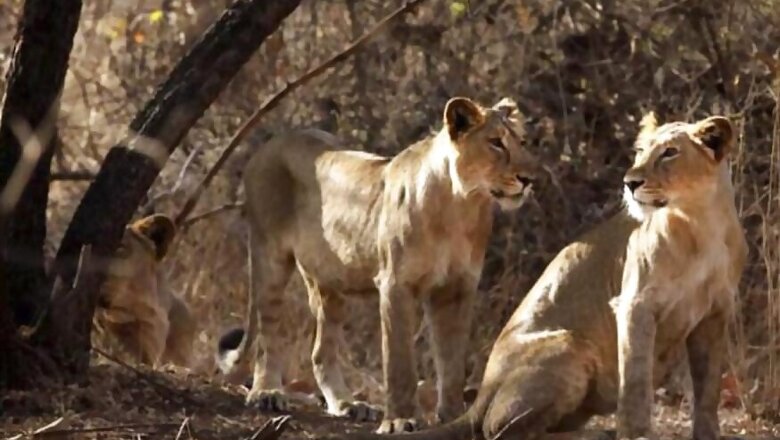
views
The world lion day is observed across the globe on August 10 every year and aims to awareness and educates people about lions and issues concerning the conservation of the species.
The Asiatic lion found in India is listed as endangered in the International Union for Conservation of Nature (IUCN) red list and are found mainly in the restricted Gir forest and its surrounding areas.
In the past, the Asiatic lion roamed over the Indo-Gangetic plains, extending from Sindh in the west to Bihar in the east. Paintings, literature and the records of lion hunt reveal that the lions were the royal animal during the Mauryan and the Gupta period and enjoyed an important place during the Mughal period too.
It was only during the British Raj when lions were hunted on a large scale and their numbers depleted from most of their distribution range.
Lions found in India are slightly smaller in caparison to their African counterparts. As per differences in morphological, Male Asiatic lions have only moderate mane growth at the top of the head so that their ears are always visible. Also, a characteristic which is seen in Asiatic lions and rarely in African lions is a longitudinal fold of skin running along its belly.
Lions mostly hunt in the night or the early morning. On average, lions hunt every two to four days when there is the availability of prey and can stay without food for more than a week. A lion needs approximately 5 to 7 kgs of meat daily, but they can consume 20 to 30 per cent of their body weight when they have plenty to eat. Dominant wild prey species of lions are Chital, Sambar, Nilgai and Wild pig.
There is a difference between the lion and the other predatory animals. Lion only hunts when it is hungry; it never believes in killing excessively. Lions are strategic hunters, and they hunt and eat together. During the daytime they take possession of water points in the jungle, they wait ambushed at these points and jump on unsuspecting animals coming for drinking water.
Lions are social animals as they live, hunt, and protect themselves and their young ones together, as a group. They live a very systematic and flexible social life with duties divided among members of a pride. The size of the pride depends upon territory, availability of water resources, sufficient amount of prey, among other factors.
An average pride compromises one or two dominant males, four or five adult females and several cubs. A family group of lionesses defend their area against other groups and also intruding males. The average size of a group is 4-6 and normally one to three groups are part of a pride. When sub-adult males reach the age of three years, they are forced to leave the group but female sub-adults may integrate with group.
Coexistence with humans
The Gir Forests of Gujarat have been inhabited by semi-nomadic pastoral communities called Maldharis. The community does not view lions as a threat to their lives and do not harm them. Maldharis primarily rear Jafrabadi breed of buffalo and Gir breed of cattle for livelihood. In this region, livestocks are reared only for dairy products and are not consumed for meat. The large population of old and weak cattle in which natural mortality is high and carcasses of the animals are available to lions for scavenging.
It is interesting to note that to minimise conflict with lions, the Maldhari herdsmen orient their herds in such a way that the unproductive cattle are placed at the leading and trailing edges. At the same time, the prized buffaloes are kept in the middle. For lions, such arrangement are conducive as it is easy for them to kill cattle due to their behaviour of flight when attacked. In contrast, buffaloes have a defence strategy and often attack lions as a cohesive group.
Challenges
Due to increasing lion population outside the protected area, there has been an increase in predation of domestic animals in the satellite areas. The presence of human and livestock population within and close to the Gir forest region and the changing economic practices of local people, especially the Maldhari youth, may harm habitat and wildlife. Rapidly changing land-use practices are also hindering the free-ranging of lions. Additionally, the infestation by un-wanted weeds and invasive alien species in the Gir forests is detrimental to the survival of the wildlife in the region.
Why save lions?
A lion is an apex predator and ensures ecological balance as it helps to control the populations of browsers and grazers. Its conservation provides protection of natural forest areas and habitats and in turn, helps in biodiversity conservation. In Gir protected area, many water resources are safeguarded in the lion kingdom.
The lion is also a part of Indian mythology and has been a part of its cultural identity. The local people in Gir and greater Gir region take pride in coexistence with nature and are emotionally attached to lions.
Although lions in the wild are restricted only in Gujarat as part of the ex-situ conservation programme, lions are found in all the major zoos of India. Due to its hunting behaviour and its social organisation, Lions are called the king of the jungle.
The Indian government is already making efforts to protect the species through various schemes and projects. As responsible citizens, it is also our moral duty to conserve the kingdom of this royal species and ensure that the status of the lion as the king is maintained because if the king is gone the entire empire collapses. However, if lions are not protected, various other species and the interconnected ecosystems of the region would be disturbed. On Lion Day 2020 let’s contribute our part by raising awareness about lion conservation through various platforms.

















Comments
0 comment